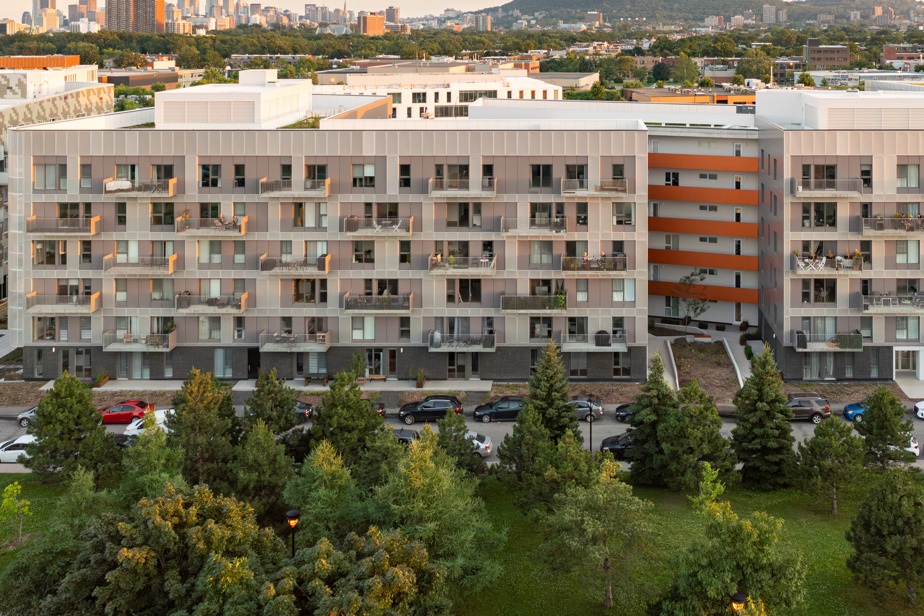In the hope of countering the exodus to the suburbs, a Rosemont NPO is seeking to convince families to stay on the island of Montreal. His solution? Large condos designed first and foremost for couples with children, but also affordable and ecological. With, as a bonus, a rich neighborhood life.
This bet, just rewarded this April 19 with a prize of excellence at the annual gala of the Order of Architects of Quebec, is that of the Société de développement Angus (SDA), which has been piloting the revitalization of immense lands for 30 years. from the former Canadian Pacific workshops. We remember that their closure in 1992 created a wave of unemployment, in addition to leaving a gaping scar at the intersection of Rosemont, Plateau Mont-Royal and Hochelaga-Maisonneuve.
“At the time, the SDA fought to obtain an option on a portion of land with the aim of creating jobs. Its mission transformed into the complete rehabilitation of a devitalized area,” explains Charles Larouche, executive vice-president of the SDA.
Complete rehabilitation? In other words, “create a living environment where people live, work and come to consume,” explains Marilou Hudon-Huot, vice-president of commercial leasing and residential development at the SDA.

PHOTO FRANÇOIS ROY, THE PRESS
This project was designed for families, and to revitalize the area.
“This idea appeared in response to the growing disinterest of corporations in business parks at the end of the 2000s,” she adds. This is where, with the land still available, we began to integrate local commerce, then housing. »
We didn’t want to do a co-ownership project for investors. Our philosophy is to create neighborhood life, not just a dormitory.
Marilou Hudon-Huot, vice-president of commercial leasing and residential development of the SDA
The keystone of the project: building a set of residential buildings that create a strong sense of belonging, like the old Montreal neighborhoods where well-rooted residents of all ages rub shoulders in public spaces and cultivate close relationships. with their local traders. “This is what currently makes central districts like Plateau Mont-Royal or Rosemont so popular,” explains Amélie Lessard, architect from the firm AEdifica.
Take root

PHOTO DAVID BOYER, PROVIDED BY V2COM
Cité Angus II, an elegant and atypical building located in the Angus district
But how do you build a building that can create a strong sense of home for today’s family of two or three children? And, therefore, make him want to put down roots?
By creating apartments that are both intimate and open to the neighborhood, but which also encourage opportunities to discover your neighbors, summarizes Hugues Daly, architect and vice-president of AEdifica.

PHOTO FRANÇOIS ROY, THE PRESS
Hugues Daly, architect and vice-president of AEdifica, with Amélie Lessard, architect
This is the whole intention behind the elegant and atypical Cité Angus II building. With its 88 units, often offering three or four bedrooms, as well as a surface area of at least 1,000 square feet, it has been entirely designed to meet the needs of families. There are around twenty different apartment formats, sometimes on two floors.

3D RENDERING PROVIDED BY AEDEFICIA
The condos were designed for families.
But its main particularity is its wide exterior passageways and its immense spiral staircase placed in the center of a winding interior courtyard. These places of passage naturally encourage its residents to circulate outside, to cross paths and, possibly, to get to know each other.
“The staircase was born from this desire to get people moving. We therefore moved the elevators further away to create a desire to use the stairs, to visit your neighbors, to participate in the active life of your yard,” explains Hugues Daly.
-

PHOTO FRANÇOIS ROY, THE PRESS
The immense spiral staircase is placed in the center of an interior courtyard ideal for meetings and exchanges.
-

PHOTO FRANÇOIS ROY, THE PRESS
Bird’s eye view of the inner courtyard and the spiral staircase
1/2
“The exterior passageways also make it possible to have through housing, therefore with windows at the front and at the back, as well as balconies on each side,” underlines Amélie Lessard.
These balconies are also particularly generous to encourage families to make the most of them. “Some are bigger than the apartment itself,” underlines Mme Lessard. Surrounded by perforated steel sunshades, they provide both privacy and protection against the heat.
“I think it works really well when I look at what people have created with these balconies,” she adds with a hint of satisfaction.
Each unit sold for a price ranging between $350,000 and $650,000. “A price made possible because we are not looking for profit. We are an NPO,” recalls Mme Hudon-Huot.
“We were able to prove that with will and innovation, it was possible to create a strong and affordable building in Rosemont,” concludes Amélie Lessard.
Rain, butterflies and foxes

PHOTO DAVID BOYER, PROVIDED BY V2COM
The project aims for LEED Gold certification
The Cité Angus II building was built with sustainable development in mind. Its superior insulation, its natural ventilation, its materials with low emissions of harmful components and its heat recovery systems were chosen with the objective of achieving LEED Gold certification.
The SDA’s dream neighborhood also meets “LEED Neighborhood Development” Platinum certification. Its design promotes social diversity, active transportation and local commerce, but it also respects the principles of sustainable development.
For example, an energy loop connects each building to recover the heat produced by air conditioners. This heat is used, among other things, to preheat domestic hot water in apartments.
In addition, thanks to a retention basin system where plants native to Quebec grow, only a tiny percentage of rainwater reaches the municipal sewers, indicates David Goulet-Jobin, engineer and project manager at the SDA.
“Locations in ecological corridors go in the direction of prevailing winds to encourage pollination and wildlife. There are lots of rabbits, raccoons, foxes coming from the railway to get to the park [Jean-Duceppe]. We also have bird houses, a bat nest box and insect hotels. The total ! », he exclaims.
